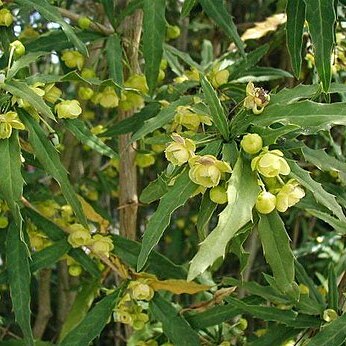Shrubs, evergreen, 1-2 m tall. Stems terete. Branches dark gray; shoots stramineous, sulcate, scarcely verruculose; spines concolorous, 1-4 cm, stout, adaxially flat or sulcate. Leaves subsessile; leaf blade abaxially yellow-green, adaxially dark green, sometimes grayish green or shiny, lanceolate or ovate-lanceolate to elliptic-lanceolate, 3.5-14 × 0.4-2.5 cm, leathery, abaxially not pruinose, midvein conspicuously raised, lateral veins slightly raised, reticulate veins inconspicuous, adaxially with slightly impressed midvein, lateral and reticulate veins conspicuous, base cuneate, margin 6-20(-40)-spinose-serrate on each side, apex acuminate. Flowers 2-8(-15)-fascicled. Pedicels ca. 3 mm. Sepals in 3 whorls; outer sepals oblong-ovate, ca. 4.5 × 4 mm, apex acute; median sepals elliptic to ovate, ca. 6.5 × 5.5 mm; inner sepals obovate, ca. 8 × 7 mm. Petals obovate, ca. 7 × 6 mm, base cuneate, with separate glands, apex emarginate or obtusely emarginate with obtuse lobes. Ovules 4 or 5. Berry red, oblong-ovoid, 8-10 × ca. 6 mm, slightly blue pruinose, style not persistent. Fl. May-Jun, fr. Jun-Oct.
More
An evergreen shrub. It grows 1.5 m tall and spreads 1.8 m wide. It is small and dense. The leaves are narrow and wavy. They are 7.5 cm long. The flowers are yellow. They are 1 cm across. The fruit are black. They are 0.5 cm long. Several named varieties have been selected.

